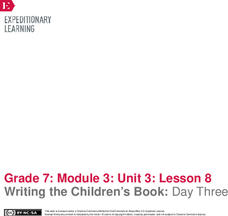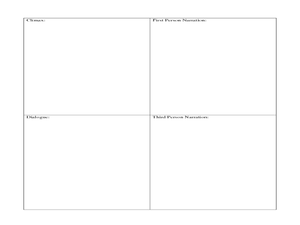Curated OER
Make a Word: Long U by Starfall
Students explore language arts by participating an on-line grammar activity. In this letter U lesson, students discuss the uses for the letter U in the English language and the different sounds that can be made from the vowel. Students...
Curated OER
Growth of a River
Students evaluate geography by drawing an image in class. In this river lesson, students identify a list of vocabulary terms associated with bodies of water. Students identify how a river is formed and draw a picture of one including the...
Curated OER
Globe Foldable
Maybe the world wasn't built in a day but kids can certainly assemble a globe in one class period using the images provided by these templates. Cut, fold, piece, glue, and voila!
EngageNY
Writing the Children’s Book: Day Three
Illustrations are a key feature of children's books. Using the resource, pupils learn about adding illustrations to their children's books. Next, as they complete their storyboards and work on their second drafts, they consider their...
Museum of the American Revolution
Leadership and Alexander Hamilton
Alexander Hamilton serves as a model in a lesson that asks young political scientists to consider the strengths and weaknesses of six different leadership styles. They read a brief overview of Hamilton's activities before, during, and...
Curated OER
Illustrated Senses Poem
Pupils choose a natural object found in Yosemite and writes a poem using their senses.
Curated OER
Illustration of Seminole Foods
Pupils identify 5 types of Seminole foods, illustrating the types of food on paper plates, bowls, and cups. Students explain their favorite foods and identify plants and animals that are part of the Seminole diet.
Curated OER
ESL School Objects Illustration
In this ESL school object vocabulary worksheet, learners read 6 labels under blank picture frames. Students draw the school supplies that are specified in the frames.
Curated OER
Emotion Illustration
In this feelings and emotions worksheet, students read three sentences about emotions. Student then finish an emotion sentence with one of their own feelings. Students then draw a picture that shows that emotion.
Curated OER
Illustration of the Model Method
Young scholars understand the steps of the model method. In this model method instructional activity, students view each step of a problem to observe the process to solve it.
National Endowment for the Humanities
George Washington: The Precedent President
Everyone knows that George Washington was the first president, but do your scholars know why that was so important? The lesson plan, the third in a sequence of three, allows learners to understand how George Washington set a precedent...
Curated OER
Glaciers and Ice Wedging
Fourth graders observe and identify a variety of weathering and geological activities in the area in which they live. This focuses primarily on what happened during the Ice Age, and how, even today, glaciers are shaping and re-shaping...
Research Laboratories of Archaeology
Pottery Traditions
As part of their study of Native American pottery traditions, class member try their hand at crafting and decorating a clay pot
Curated OER
Earthquakes and Volcanoes
Even though volcanoes look alike, they can be very different based on the types of lava that erupts from their surface. Learn about strata volcanoes, shield volcanoes, and the varying viscosity of lava with an engaging hands-on activity....
Houghton Mifflin Harcourt
Upper and Lower Case Concentration
Play a wild game of memory with your youngsters. These adorable animal-themed tiles include every uppercase and lowercase letter of the alphabet. Kids match the uppercase and lowercase letters to remove them from the board.
Scholastic
Developing a Main Character
Asking kids to craft their own stories? Get them starting with a character planning sheet that asks them to identify the character's likes and dislikes, his or her strengths and fears, a goal the character wants to achieve, and the...
Curated OER
Illustrating the Elements of a Story
Explore the elements of a story with this two-page graphic organizer. Readers write and draw descriptions of each element, including setting, plot, conflict, rising action, climax, dialogue, and narration.
Curated OER
Cartoons for the Classroom: Sarcasm, Irony, and Satire
Satire, sarcasm, or irony? Editorial cartoons have long been the tool artists use to express their opinions about politics and politicians. Kevin "Kai" Kallaugher's four-panel cartoon offers readers an opportunity to examine how he uses...
Positively Autism
Please Wait to Ask Questions
Learning to wait, though difficult, is an important social skill. Here are two cards that will help kids learn when it is okay to ask questions and when they must wait.
K12 Reader
What Is a Simile?
As fun as a barrel of monkeys, this figurative language worksheet will engage your students in learning to write similes. Asking them to first think of adjectives describing the six nouns listed on the page, this exercise has young...
For the Teachers
Sequence Plot Chart
Your kids can identify the plot sequence of a short story, but what about an informational article? Have them examine the chronological order of events in informational texts with a lesson on the sequence of events.
Curated OER
The Glass Menagerie: K‐W‐H‐L Strategy
Readers of Tennessee Williams' award winning memory play, The Grass Menagerie, will be neither disappointed nor discouraged by this prereading strategy that asks learners to consider what they know about Williams and his play, what they...
Sargent Art
Symmetry: A Design Problem
As part of a study of design, young artists examine an example of a formal (symmetrical) design and then, following step-by-step directions, create their own.
Sargent Art
Improvisation: Dada and Surrealism
Images of works by Salvador Dali, Luis Bunuel, and Man Ray launch a study of Dada and Surrealism. After critiquing works by these and other artists, class members gather their own images and arrange them into a cohesive composition.

























